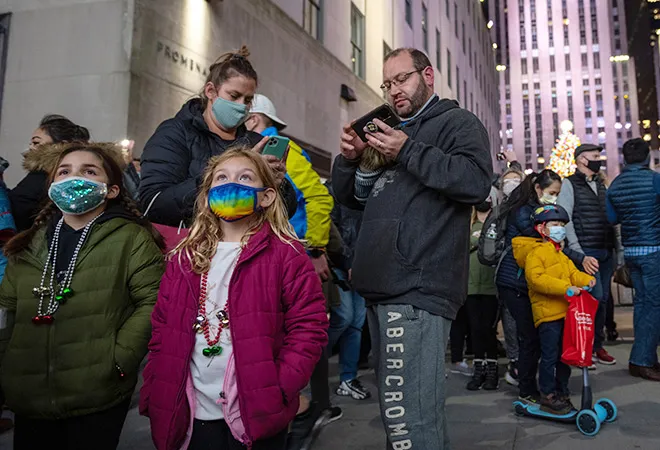-
CENTRES
Progammes & Centres
Location

Turns out, we’re getting our world back.
Within hours of UK greenlighting a two-shot Covid-19 vaccine from Pfizer, US health officials are looking to December 10 for the first of many emergency use approvals to come through after meetings scheduled on that day and December 17 at the Food and Drug Administration (FDA).
That’s the point at which 11 full months of a catastrophic response to the US outbreak slowly begins to change direction, poke by poke, and opens up the path to good news in small bursts. Covid-19 won’t go away though. Americans are determined to gather in December, just like they did in November, and throughout the year, putting entire communities in jeopardy. The let-it-rip messaging is coming straight from the top. The White House, which became a Covid cluster this Fall, plans to hold lots of holiday parties in the winter too. Morgues across the country are already out of space for the dead, freezer trucks are being pressed into service in several states. “We’re likely to lose another 250,000 people dead between now and January,” President elect Biden told a roundtable on December 2. “You hear me? Because people aren’t paying attention.” The nightmare will drag itself out through the year’s coldest days, as the Trump presidency draws to a close.
On the sunny side, vaccines which typically take years to develop and bring to market are here in record time. A promising vaccine technology that was many years in the making has been translated into a shot that will be available at population scale before year end. In a month of fast moving vaccine news, here are 10 developments we are tracking.
Dec. 1: Centers for Disease Control and Prevention advisory committee voted on who gets the vaccine first.
Dec. 4: Deadline for states to request Pfizer/BioNTech vaccine and supply shipping details.
Dec. 10: US FDA meeting to debate if there’s enough evidence for emergency use of the Pfizer/BioNTech vaccine.
Dec. 11: Deadline for states to request doses of the Moderna vaccine and supply shipping details.
Dec. 17: US FDA meeting to debate if there’s enough evidence for emergency use of Moderna vaccine.
Officials from the US vaccine program Operation Warp Speed, who now look and sound less politically pressured, say they’re ready to start vaccinating health care workers within 24 to 48 hours of receiving the US Food and Drug Administration’s go ahead. That will be the “Phase 1a” rollout. Shots will be sent to each state’s predetermined locations, and shots begin going into arms as per states’ plans. Warp Speed chief advisor Moncef Slaoui is confident that at least 100 million people would have got coronavirus shots by the end of February 2021 and this operation would have covered the entire “at risk” population comprising the elderly, frontline workers and those with comorbidities.
A high powered vaccine advisory panel - Advisory Committee on Immunization Practices - voted 13-1 to recommend that health care workers and nursing home residents should be the first to receive coronavirus vaccine shots when they become available. The two groups cover about 24 million people out of a US population of about 330 million. At the time of the recommendations, on December 1, panel members reported that one person is dying of Covid-19 per minute in the US.
Burden of disease figures prominently in the decision to bring nursing home residents into the ambit early. CDC experts noted that 40 percent of the deaths in the US have been among those in long term care facilities. About 3 million people are living in nursing homes, long-term chronic care hospitals, and other U.S. long-term care facilities. At current levels, those patients and the staff members who care for them account for 6% of the nation’s coronavirus cases and 39% of deaths, CDC officials said.
Both Moderna and Pfizer/BioNTech reported their vaccines worked consistently across age groups, ethnicities, and genders and protect older people most at risk of dying . More than 7000 participants in the Moderna trial were over age 65. In the Pfizer/ BioNTech trial, approximately 41% of global and 45% of U.S. participants are 56-85 years of age. This is vital information for the agencies (FDA and CDC) deciding on approval as well as priority groups. Moderna reported 94.1% vaccine efficacy against Covid-19, 100% vaccine efficacy in “severe” cases. Pfizer’s emergency use application is based on 95% efficacy in a study that recruited nearly 44,000 participants. The Moderna and Pfizer vaccines each require two doses, taken three or four weeks apart. The first dose alone won’t do so the first full round of vaccinations will be closed out only mid January 2021. For Pfizer’s vaccine, the second dose is given three weeks after the first. For Moderna’s, the second shot comes four weeks after the first. Slaoui is hoping for a “breakthrough” from a one-shot Johnson & Johnson vaccine that has now recruited more than 28,000 subjects. By Spring, US health experts believe AstraZeneca and Johnson & Johnson could get emergency use authorization from the FDA. So too, some additional therapeutics. Anthony S. Fauci, director of the National Institute of Allergy and Infectious Diseases, thinks Covid-19 vaccines will most likely be available to most adult Americans by May and certainly before June, 2021.
Next question - when will we have a vaccine for kids? In the US, children make up more than one fifth of the total population. The American Academy of Pediatrics sounded the alarm two months ago, questioning the logic of emergency use authorisation without data on efficacy among children. “Children must be included in vaccine trials to best understand any potential unique immune responses and/or unique safety concerns. Questions about unknown safety concerns will not be answered by posing questions, but only through carefully designed trials which include children. It would also be less than desirable to have one or more SARS- CoV-2 vaccines licensed or available under Emergency Use Authorization (EUA) at a time when no data have been collected on the safety, tolerability, dose, and regimen for children,” the AAP wrote. Right around that time, Pfizer began enrolling participants aged 12 and over in its Phase 3 trial. Moderna announced on December 2 that it will start looking for 3,000 children willing to join its mRNA vaccine trial. Anthony S. Fauci, director of the National Institute of Allergy and Infectious Diseases, has said it could take “months” before those younger than 18 can get shots in arms. When that happens, teenagers are likely to get vaccinated before younger kids, according to Dr. Robert Frenck, who’s in charge of the Pfizer vaccine trial for children at Cincinnati Children’s Hospital Medical Center.
Hospitals at breaking point across the U.S. Nearly 100,000 people are hospitalised, and retired nurses and doctors are being asked to don their scrubs again. New graduates are being recruited at top salaries in a desperate bid to ease staff shortages. Nurses are openly sobbing in television interviews and stray conversations, recounting tales of holding the hands of patients saying their last goodbyes over a video call. The worsening outbreak prompted a dire warning from the head of the Centers for Disease Control and Prevention, Dr. Robert Redfield: “The reality is December and January and February are going to be rough times. I actually believe they are going to be the most difficult time in the public health history of this nation.” Fauci has also warned that a nightmarish “surge upon surge” will grip the United States this winter.
Despite intensifying pressure from President Donald Trump to speed up the approval process, the head of the FDA said the agency would take whatever time was needed to “get this right”. Hahn's comments came soon after he was summoned to the White House around questions on the speed of approvals. Trump wanted this done before the US election.
U.S. hospitalizations and deaths are skyrocketing out of control. The virus is blamed for over 272,000 deaths and more than 13.8 million confirmed infections in the United States. Nearly 37,000 Americans died of COVID-19 in November alone. A record 96,000 people were in the hospital with the virus in the U.S. as of November 30. The U.S. is seeing on average more than 160,000 new cases per day and almost 1,470 deaths, which is as bad as it was back in May. Some 2,473 Americans died from Covid-19 on December 1.
The battered and bruised Centers for Disease Control and Prevention CDC is emerging from under the furniture, now that the Trump presidency is well and truly into its lame duck season. The agency’s health communication has gotten back some of its pre-Covid sheen in recent weeks. In its latest move, the CDC has shortened the recommended length of quarantine after exposure to someone who is positive for COVID-19 from 14 to 10 days and 7 days in case of a negative test result. CDC warned Americans against Thanksgiving travel and is now warning against winter holiday travel and pushing for mask usage - common sense guidance that was snuffed out by the White House from February till Election Day. The renewed confidence is expected to get a booster shot in the week of December 7. President-elect Joe Biden will be naming his top health care officials and his choice to lead the Department of Health and Human Services.
The views expressed above belong to the author(s). ORF research and analyses now available on Telegram! Click here to access our curated content — blogs, longforms and interviews.

Nikhila Natarajan is Senior Programme Manager for Media and Digital Content with ORF America. Her work focuses on the future of jobs current research in ...
Read More +